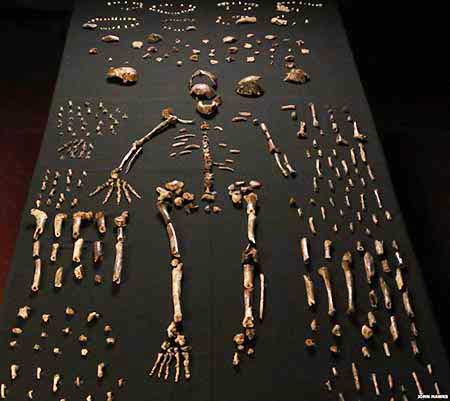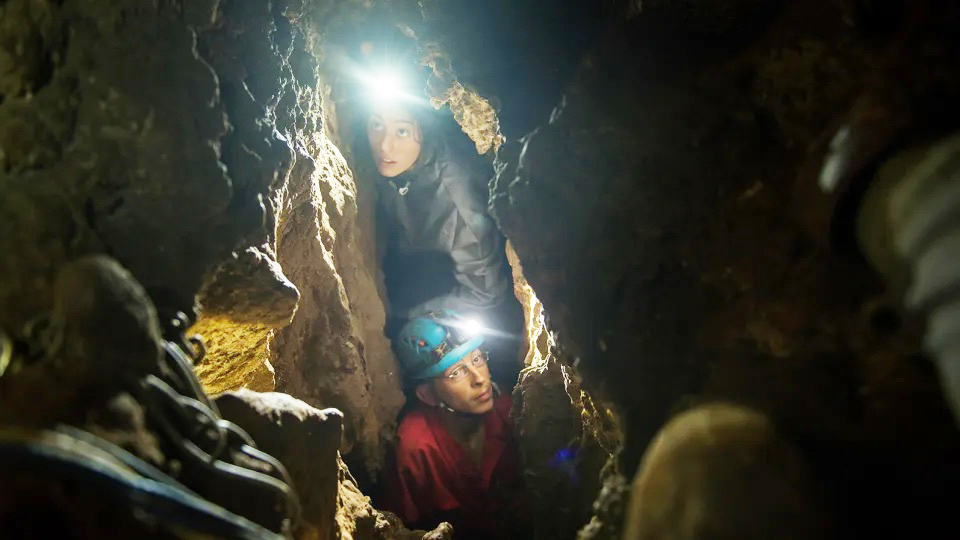
Map of the Rising Star Cave, marking the Dinaledi Chamber
in yellow and the Lesedi Chamber in red
Homo Naledi is an extinct species of archaic human discovered in 2013 in the Rising Star Cave, Cradle of Humankind, South Africa dating to the Middle Pleistocene 335,000–236,000 years ago. The initial discovery comprises 1,550 specimens, representing 737 different elements, and at least 15 different individuals. Despite this exceptionally high number of specimens, their classification with other Homo remains unclear.
Along with similarities to contemporary Homo, they share several characteristics with the ancestral Australopithecus and early Homo as well (mosaic evolution), most notably a small cranial capacity of 28.4-37.2 cu in), compared with 78-81 cu in) in modern humans.
They are estimated to have averaged 143.6 cm (4 ft 9 in) in height and 39.7 kg (88 lb) in weight, yielding a small encephalization quotient of 4.5. H. naledi brain anatomy seems to have been similar to contemporary Homo, which could indicate comparable cognitive complexity.
The persistence of small-brained humans for so long in the midst of bigger-brained contemporaries revises the previous conception that a larger brain would necessarily lead to an evolutionary advantage, and their mosaic anatomy greatly expands the known range of variation for the genus.
H. naledi anatomy indicates that, though they were capable of long-distance travel with a humanlike stride and gait, they were more arboreal than other Homo, better adapted to climbing and suspensory behavior in trees than endurance running.
Tooth anatomy suggests consumption of gritty foods covered in particulates such as dust or dirt.
Though they have not been associated with stone tools or any indication of material culture, they appear to have been dextrous enough to produce and handle tools, and likely manufactured Early or Middle Stone Age industries.
On September 13, 2013 while exploring the Rising Star Cave system in the Cradle of Humankind, South Africa, cavers Rick Hunter and Steven Tucker found hominin fossils at the bottom of the Dinaledi Chamber.
On the 24th, they returned to the chamber and took photos, which they showed to South African palaeoanthropologists Pedro Boshoff and Lee Rogers Berger on October 1. Berger assembled an excavation team which included Hunter and Tucker, the so-called "Underground Astronauts".
The chamber had been entered at least once before, by cavers in the early 1990s. They rearranged some bones and may have caused further damage, although much of the floor in the chamber had not been walked on prior to 2013.
It lies about 80 m (260 ft) from the main entrance, at the bottom of a 12 m (39 ft) vertical drop, and the 10 m (33 ft) long main passage is only 25–50 cm (10 in - 1 ft 8 in) at its narrowest.
In total, more than 1,550 pieces of bone belonging to at least fifteen individuals (9 immature and 6 adults) have been recovered from the clay-rich sediments. Berger and colleagues published the findings in 2015.

Homo naledi: Hands, feet suggest 'jack of all trades' BBC - October 6, 2015
The human ancestor Homo naledi was something of an all-rounder, able to move efficiently on the ground but also adept at climbing in trees. Scientists have just published a second batch of papers on the creature whose remains were sensationally found deep inside a South African cave. The scholarly articles focus entirely on naledi's hands and feet. Its feet were clearly those of a walker while the hands had curved fingers to grasp and hold on to branches. But the hands also show a remarkable level of modernity that is only really evident in late Homo species, such as today's humans and our now extinct cousins, the Neanderthals.
New human-like species discovered in S Africa BBC - September 10, 2015
Scientists have discovered a new human-like species in a burial chamber deep in a cave system in South Africa. The discovery of 15 partial skeletons is the largest single discovery of its type in Africa. The researchers claim that the discovery will change ideas about our human ancestors. The fossils represent 737 anatomical elements - including the parts of the skull, jaw, ribs, teeth, limbs, and inner ear bones - from old, adult, young, and infantile individuals.
The Oldest Known Burial Site in The World - Found in South Africa - Wasn't Created by Our Species but by Homo naledi a tree-climbing Stone Age hominid Science Alert - June 20, 2024
The findings challenge the current understanding of human evolution, as it is normally held that the development of bigger brains allowed for the performing of complex, "meaning-making" activities such as burying the dead.
Extinct human relative buried their dead 100,000 years before modern humans did Live Science - June 5, 2023

Mysterious species - Homo Naledi - buried their dead and carved symbols 100,000 years before humans CNN - June 5, 2023
Researchers have uncovered evidence that members of a mysterious archaic human species buried their dead and carved symbols on cave walls long before the earliest evidence of burials by modern humans.
The brains belonging to the extinct species, known as Homo naledi, were around one-third the size of a modern human brain.
The revelations could change the understanding of human evolution, because until now such behaviors only have been associated with larger-brained Homo sapiens and Neanderthals.
Fossils belonging to Homo naledi were first discovered in the Rising Star cave system in South Africa during excavations in 2013. The cave system is part of South Africa's Cradle of Humankind, a UNESCO World Heritage Site encompassing an area where scientists have found fossils of multiple ancient human ancestor species - remains that are helping to unlock the story of human evolution.
Paleoanthropologist and National Geographic Explorer in Residence Dr. Lee Berger and his team of 'underground astronauts' have continued their work in the extensive, dangerous caves to better understand the extinct hominins, or ancient human ancestors.
Now, the research team has discovered the remains of Homo naledi adults and children that were laid to rest in the fetal position within cave depressions and covered with soil. The burials are older than any known Homo sapiens burials by at least 100,000 years.
During the work to identify the cave burials, the scientists also found a number of symbols engraved on the cave walls, which are estimated to be between 241,000 and 335,000 years old, but they want to continue their testing for more precise dating.
The symbols include deeply carved hashtag-like cross-hatchings and other geometric shapes. Similar symbols found in other caves were carved by early Homo sapiens 80,000 years ago and Neanderthals 60,000 years ago and were thought to have been used as a way to record and share information.
These recent findings suggest intentional burials, the use of symbols, and meaning-making activities by Homo naledi. It seems an inevitable conclusion that in combination they indicate that this small-brained species of ancient human relatives was performing complex practices related to death. That would mean not only are humans not unique in the development of symbolic practices, but may not have even invented such behaviors.
Exploring the labyrinth-like Rising Star cave system and its chambers isn't for the faint of heart.
The team has mapped over 2.5 miles (4 kilometers) of the caves so far, which have a vertical depth of 328 feet (100 meters) and expand for more than 656 feet (200 meters) in length, said the studies' lead geologist Dr. Tebogo Makhubela, senior lecturer of geology at the University of Johannesburg.
The cave system includes deadly steep drops and tiny passageways like Superman's Crawl, a tunnel measuring 131 feet (40 meters) long and 9.8 inches (25 centimeters) across, requiring the researchers to belly crawl their way through.
Homo naledi shared some similarities with humans, like walking upright and manipulating objects by hand, but members of the species had smaller heads, a shorter stature, and were thinner and more powerfully built, Berger said.
Homo naledi's shoulders - which were oriented for better climbing - and teeth shared similarities with earlier hominins like Australopithecus.
The researchers have found many Homo naledi fossils throughout the caves, including the remains of very young infants and aged adults, to help them understand Naledi as a population. As the team continued deeper into the caves, it became clear that Homo naledi was very familiar with and using broad parts of the cave system. When Berger and his team announced the discovery of Homo naledi in 2015, they suggested it was possible that the species deliberately disposed of their dead in the cave.
Other burial sites were dug horizontally into slopes, with bodies placed inside, showing that the remains didn't end up there by other, non-deliberate means.
Within one of the graves is a tool-shaped rock, buried next to the hand of a Homo naledi adult. Within a passage above the burials, in an antechamber, is a wall covered with rock engravings.
The deeply carved geometric shapes appear on dolomite rock walls that reach 4.5 to 4.7 on Mohs Hardness Scale, which helps researchers assess the scratch resistance of minerals. Dolomite is halfway to a diamond (at the top of the scale) in terms of hardness, which means it would have taken an extreme amount of time and effort to carve into the walls.
The team of explorers believes that Homo naledi, and not Homo sapiens, are responsible for the carvings because there is no evidence that humans have ever been inside the caves.
Homo naledi was able to see what they were doing inside the caves by using fire. There is evidence spread throughout the caves, including soot, charcoal and burnt bone, to show that they were actively setting fires.
Both the burials and the symbols imply that Homo naledi was capable of engaging in meaningful behavior.
The meaning of the symbols is unclear Researchers can't say whether they were used as a type of language or communication within the species. What they can say is that these are intentionally made geometric designs that had meaning for Naledi which means they spent a lot of time and effort and risked their lives to engrave these things in these places where they're burying bodies.
The naledi findings suggest that larger brains can't be the only connection with complex behavior that researchers once assumed related only to humans.
The challenge here, then, is that we now know that Homo naledi, in addition to Homo sapiens and Neanderthals and Denisovans and a few others, were engaging in the kind of behavior that we, even just a few decades ago, thought was unique to us which means we need to rethink the timing of fire use, of meaning-making and of the burial of the dead in hominin history.
Some of the engravings reveal signs of stray lines and even erasure, similar to sand being used to "erase" markings before another carving was completed on top.
ANCIENT AND LOST CIVILIZATIONS